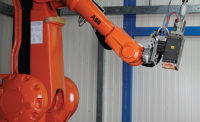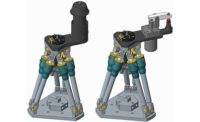Flexible Fixturing for Robotic Welding

This three-finger adaptive gripper can grab any part regardless of size or shape, position it on an assembly, and hold it tight during welding. Photo courtesy Robotiq Inc.

Using a robot equipped with an adaptive gripper to hold parts during welding can be more economical than buying multiple jigs and swapping them out with each production run. Photo courtesy Robotiq Inc.

Although Robotiq’s engineers used a three-finger gripper in their demonstration welding cell, a two-finger gripper could also work. Photo courtesy Robotiq Inc.

Tests have shown that this two-finger gripper can perform more than 10 million cycles with no compromise in performance. Photo courtesy Robotiq Inc.




Jigs are often used to position parts for welding on an automated assembly line. However, a big challenge for many manufacturers today is mixed-model production. Maintaining jigs for every welded assembly can be expensive. Moreover, each time the assembly changes, the fixture must be changed, too, and that adds cycle time.
Now, there’s an alternative: a robot equipped with an adaptive gripper. The gripper can grab any part regardless of size or shape, position it on the assembly, and hold it tight during welding.
Robotiq offers three adaptive grippers that would be a good fit for this application:
- a three-finger gripper.
- a two-finger gripper with an 85-millimeter stroke.
- a two-finger gripper with a 200-millimeter stroke.
Even with a second robot and gripper, this option can be more economical than buying and maintaining multiple jigs and swapping them out with each production run. Because the gripper does not need to be changed to start working on another model, changeover time is eliminated.
Working with the Industrial Robotics and Vision Center—a technology transfer center in Lévis, Quebec—Robotiq recently tested a robotic cell to prove the feasibility of flexible fixturing for automated welding. The cell was equipped with two M-170iC six-axis robots from FANUC Robotics and two machine vision cameras from Mightex Systems.
Our goal was to answer the following questions:
Could a robot equipped with an adaptive gripper replace jigs for automated welding?
How consistent and precise could such a system perform?
Could the system resist the rigors of welding in a mass-production environment?
For the test, one robot would position a part on a structure with a repeatability of ±1 millimeter and while the other welded it in place. Because the system was designed for mass production, it had to reproduce each step numerous times with the same accuracy.
Gripper Durability
To assess the gripper’s durability, we made it open and close continuously until it became nonfunctional. The gripper performed both full and partial closures. A partial closure allows the gripper to be faster at grabbing the parts since the closure is already partially done when reaching the piece.
This test ran seven days a week, 24 hours a day, for more than six months. Regular inspections were made to determine when the grippers would require maintenance. The test may sound harsh, but it gave us valuable information that we used to modify the gripper to improve its durability.
To further protect the gripper, we developed a silicone glove to insulate it from high temperatures. The glove was designed so that:
No welding sparks could penetrate the glove.
No welding sparks could burn the glove.
The glove material would resist the heat generated by arc welding.
Our tests on the glove were simple. The gripper held a metallic object while welds of various lengths were made at different distances from the glove. Different metals were welded, including stainless steel since it creates a lot of sparks.
After each run, we inspected the glove for damage. Our tests indicated that the glove provided satisfactory protection. Some sparks did damage the glove, but it was superficial. However, in other tests, the glove appeared to tear under certain conditions. As a result, we are in the process of improving its design.
Precision and Repeatability
To test the precision of the welding cell, the equipment first had to be calibrated. A special tool was used to calibrate the gripper position on the robot. The cameras were used as measurement tools, and images were calibrated with a commercial calibration grid. This step was necessary because the camera had to recognize and convert pixels in three-dimensional space to locate the workpiece. With that done, the robot’s movements were then calibrated using the cameras.
For the precision and repeatability tests, two cameras were used. First, the cameras themselves were tested. Several images of fixed objects were taken by the cameras to measure distances. Next, a camera was aimed at the gripper while it performed several open and close sequences. With each actuation, the position of the gripper was recorded. Then, the robot was tested by moving it to a preprogrammed point and using the cameras to measure its position.
Finally, the entire system was tested. Camera one was used to locate the part to be picked. Then, the robot arm with the gripper moved to that location and grabbed the part. Next, the robot brought the part to a specific point on a fictive assembly. The second camera then measured the coordinates of the final destination.
These movements were repeated several times. The results helped to determine the system’s precision. The same test was later repeated with gripper wearing the silicone glove.
Our goal was a repeatability of ±1 millimeter. In every phase of testing, we achieved a repeatability of less than ±1 millimeter.
Equipping the gripper with the glove yielded less accurate results (±0.277 millimeter vs. ±0.075 millimeter without the glove), because the glove is made of a flexible material. When it grabs a part, the silicone is compressed, which may cause the part to deviate.
Robotic Welding Cell
After all the tests, the system was ready at last to work as a functional welding cell. To test capability of the cell, we used a representative assembly from a customer. First, we optimized the position of all the elements: the cameras, the robot with the adaptive gripper, and the welding robot. Then, a commercial communication system, EtherNet/IP, was set up between the robots. The algorithms previously used in other tests were slightly modified. Afterwards, all the pieces and weld positions on the assembly were programmed and integrated into the cell.
The cell processed 10 pieces, performing 18 spot welds and 10 continuous welds. The quality of positioning exceeded expectations, with a repeatability of ±0.1 millimeter (±0.3 millimeter with the glove).
Although the tests were performed with our three-finger gripper, either of the two-finger models could also have worked. The two-finger grippers are mechanically simpler and would likely be more robust in an automated welding environment. Our tests have shown that these grippers can perform more than 10 million cycles and still work perfectly.
The two-finger gripper with a 200-millimeter stroke would be our first choice for welding applications. This gripper can handle parts up to 50.5 pounds and apply 169 pounds of force. Moreover, its sealed casing protects it from the welding environment.
Our tests prove that adaptive grippers can replace most of the welding jigs at many assembly plants. These grippers can adapt to any part size and shape and can hold them firmly during assembly.
Further research must be done to improve the whole system. Whether for welding, bin picking, vision or the protective glove, we will continue to work on this project to upgrade actual production systems.
For more information, call 888-ROBOTIQ or visit http://robotiq.com/en.
Looking for a reprint of this article?
From high-res PDFs to custom plaques, order your copy today!









